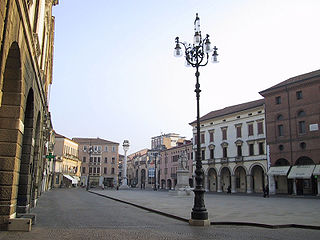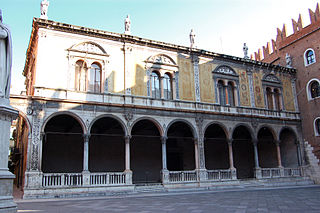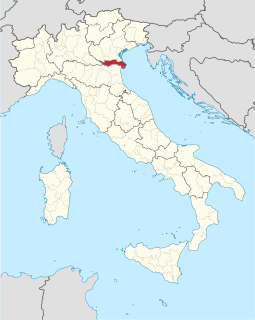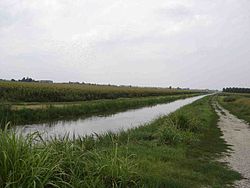
Adria is a town and comune in the province of Rovigo in the Veneto region of northern Italy, situated between the mouths of the rivers Adige and Po. The remains of the Etruscan city of Atria or Hatria are to be found below the modern city, three to four metres below the current level. Adria and Spina were the Etruscan ports and depots for Felsina. Adria may have given its name during an early period to the Adriatic Sea, to which it was connected by channels.

The Adige is the second longest river in Italy after the Po, rising in the Alps in the province of South Tyrol near the Italian border with Austria and Switzerland, flowing 410 kilometres (250 mi) through most of North-East Italy to the Adriatic Sea.

Rovigo is a town and comune in the Veneto region of Northeast Italy, the capital of the eponymous province.

The Province of Verona is a province in the Veneto region of Italy. The eastern bank of Lake Garda is near the province. Its capital is the city of Verona. The city is a UNESCO World Heritage Site.

The Province of Rovigo is a province in the Veneto region of Italy. Its capital is the city of Rovigo. It borders on the north with the provinces of Verona, Padua and Venice, on the south with the province of Ferrara, on the west with the province of Mantua, and on the east with the Adriatic Sea.

The Huai River, formerly romanized as the Hwai, is a major river in China. It is located about midway between the Yellow River and Yangtze, the two largest rivers in China, and like them runs from west to east. Historically draining directly into the Yellow Sea, floods have changed the course of the river such that it is now a major tributary of the Yangtze. The Huai is notoriously vulnerable to flooding.

The Mincio is a river in the Lombardy region of northern Italy.

Polesine is a geographic and historic area in the north-east of Italy whose limits varied through centuries; it had also been known as Polesine of Rovigo for some time.

The Via Popilia is the name of two different ancient Roman roads begun in the consulship of Publius Popilius Laenas. One was in southern Italy and the other was in north-eastern Italy.

Legnago is a town and comune in the Province of Verona, Veneto, northern Italy, with population (2012) of 25,439. It is located on the Adige river, about 43 kilometres (27 mi) from Verona. Its fertile land produces crops of rice, other cereals, sugar, and tobacco.

Badia Polesine is a comune (municipality) in the Province of Rovigo in the Italian region Veneto, located about 70 kilometres southwest of Venice and about 25 kilometres west of Rovigo. It is part of the upper Polesine, and is bounded by the Adige river, which separates the communal territory from the province of Padua.

Taglio di Po is a comune (municipality) in the Province of Rovigo in the Italian region Veneto, located about 50 kilometres (31 mi) south of Venice and about 35 kilometres (22 mi) east of Rovigo, in the lower Polesine.

Cavarzere is a comune (municipality) in the Metropolitan City of Venice in the Italian region of Veneto, located about 35 kilometres southwest of Venice.

The Reno is a river of Emilia-Romagna, northern Italy. It is the tenth longest river in Italy and the most important of the region apart from the Po.

The so-called breach at Cucca traditionally refers to a flood in the Veneto region of Italy that should have happened on October 17, 589 according to the chronicles of Paul the Deacon. The Adige river overflowed after a "deluge of water that is believed not to have happened after the time of Noah"; the flood caused great loss of lives, and destroyed part of the city walls of Verona as well as paths, roads and large part of the country in lower Veneto.
Adria was a former channel of the Po river delta, passing by the town of Adria, that ceased in the 1st century BC.
The Giardino Botanico Litoraneo di Porto Caleri, also known as the Giardino Botanico Litoraneo del Veneto, is a nature preserve and botanical garden located on Via Porto Caleri, Rosolina Mare, Rosolina, Province of Rovigo, Veneto, Italy. It is open several days a week in the warmer months.

The Po is a river that flows eastward across northern Italy starting from the Cottian Alps. The Po flows either 652 km (405 mi) or 682 km (424 mi) – considering the length of the Maira, a right bank tributary. The headwaters of the Po are a spring seeping from a stony hillside at Pian del Re, a flat place at the head of the Val Po under the northwest face of Monviso. The Po then extends along the 45th parallel north before ending at a delta projecting into the Adriatic Sea near Venice. The slope of the valley decreases from 0.35% in the west to 0.14% in the east, a low gradient. Along its path lie 450 standing lakes.

Pietro Paleòcapa was an Italian scientist, politician and engineer.

















